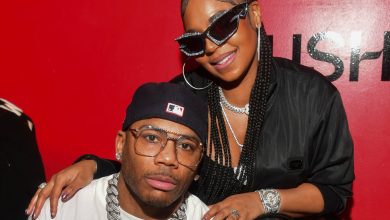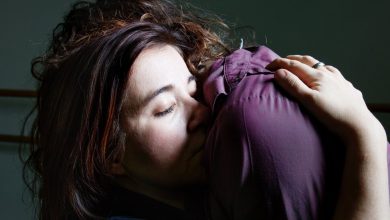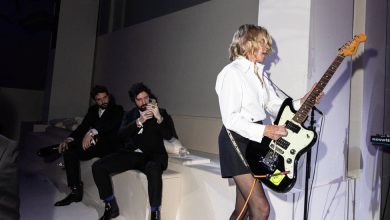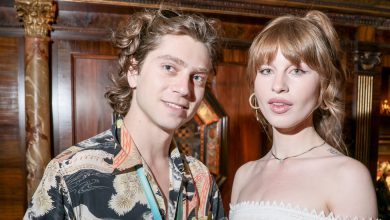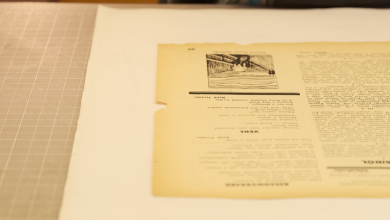Remembering Grace Mirabella and Her Inventive Magazine

One day in 1989, Paul Sinclaire was directing a photo shoot in Los Angeles when he got a call from Grace Mirabella. After having been unceremoniously fired from her job at Vogue, where she was editor in chief from 1971 to 1988, Ms. Mirabella had a new magazine project in the works and found a backer in Rupert Murdoch.
“She said: ‘Do you want me to give you the punchline? The magazine is going to be called Mirabella,’” Mr. Sinclaire said. “I remember saying, ‘Gee, Grace, that’s quite a responsibility to use your own name.’”
Still, he accepted a job as special projects editor, joining fellow Vogue alumnae Jade Hobson, who became the executive creative director, and Amy Gross, who became the editor.
Ms. Mirabella, who died in late December at 92, had a concept for a new kind of women’s magazine in Mirabella that incorporated both style and serious journalism. She convinced a lot of talented people, who saw her as a visionary, to come along for the ride. Many would go on to shape women’s media and fashion for decades; some, like Samira Nasr, Nina Garcia and Stellene Volandes, now oversee major magazines.
“It was for women who were interested in everything,” said Ms. Gross, who later became the editor in chief of O, The Oprah Magazine. “Definitely not for the 20-year-olds. Ms. Mirabella didn’t say an age bracket, but we understood it was for women like us. Not old women, but older.”
Mr. Sinclaire described Mirabella as a magazine about “how women and their partners lived. ‘Charm,’ ‘ease,’ ‘fast’ — those were her words. She brought those words to life.”
Ms. Mirabella grew up in a middle-class family in Maplewood, N.J., and started at Vogue in the 1970s. She married in her 40s and lived in a townhouse on East 62nd Street with her husband, Dr. William Cahan, an esteemed thoracic surgeon, and they didn’t have children. She wore tailored clothes from Geoffrey Beene and Yves Saint Laurent, printed socks and Elsa Peretti bracelets that colleagues could hear clinking as she walked down the hall. But she never wanted the magazine to be about her or an inner circle.
“She always said we aren’t doing a magazine for our 10 best friends,” said Kathryn MacLeod, Mirabella’s bookings editor.The goal was “a magazine for women in the world.”
‘Style is the antidote to trendiness.’
Brigitte Lacombe, the celebrated French photographer, shot the cover for the premiere issue, which appeared in June 1989, as well as most of the early covers. The image was a close-up crop of Diandra Douglas, a film producer and the former wife of the actor Michael Douglas. “Anything was possible,” Ms. Lacombe said. “There was no format. It was very open.”
Covers in that first year were naturalistic and unfussy, with models or celebrities often wearing the kind of understated, tailored sportswear Ms. Mirabella herself preferred. The stars had zeitgeisty appeal. October 1989 featured Demi Moore with her famous, newly cropped hair, lying under a barrage of provocative headlines including: “The diet cops are watching you,” “Marilyn Monroe — when she was happy,” “Sweaters to kid around in,” “The last annual sex survey,” “Gloria Vanderbilt, novelist at last.”
The May 1992 issue featured the actress Sharon Stone on the cover photographed in the desert. In an email, Ms. Stone remembered Ms. Mirabella: “She was so gracious and elegant,” Ms. Stone wrote, adding, “I’m honored to be a small part of her astounding legacy.”
The tone of Mirabella felt like a rejection of the stifling formality of Vogue. “We live in an age when everyone is obsessed with what’s trendy,” Ms. Mirabella wrote in her Mirabella Dictu column in the first issue. “Style is the antidote to trendiness.”
Fashion coverage in Mirabella could include a sly mention of Gianni Versace as “the Bob Mackie of Italy.” Sweaters were modeled by joyful children, and Chanel haute couture was depicted in illustrations. A photo of an outrageous head-to-toe houndstooth Jean Paul Gaultier cat suit looks like it could be in a current Balenciaga collection.
A fashion feature like “Table Hopping,” in September 1990, included Yves Saint Laurent leather tuxedo jackets and Emanuel Ungaro bustier dresses to be worn at Sardi’s or the Royalton. (“These days, restaurants are the hottest stops on the New York City social circuit. And depending on whether you go uptown or down, here are clothes that will fit the bill,” the article read.)
In addition to fashion, there were cultural essays and think pieces that presaged the discussion on gender and celebrity that is common today. The debut issue had an article that asked whether male movie stars were “bland.”
An article by the writer Lynn Darling called “The Androgynous Zone” said that “androgyny is not about women looking like men, or men like women. It’s a form of freedom.” In the April 1991 issue, the writer Adam Platt covered Douglas Wilder, the first elected Black governor in the United States, pondering if he could be the first Black president. A May 1992 article by the writer Elaina Richardson about Hillary Clinton in the run-up to the 1992 presidential election had this line: “It’s hard not to wonder if the voice in her head sometimes whispers that it would have been easier just to go out there and do it herself.”
Ms. Mirabella seemed intent on having fun with her subject matter. In “What Does Tom Cruise Really Eat for Breakfast?” a meditation on the gushiness of celebrity journalism, the writer Elizabeth Kaye noted that “the most common type of celebrity journalist celebrates and admires anyone who has not committed a murder since breakfast.”
A little bit of literary flourish was not unwelcome. An April 1991 article on Marla Maples, Donald Trump’s companion at the time, examined the relationships between beautiful women and powerful men. It contained the passage: “to have personal access to beauty and youth, to possess what other men must ogle from a distance — these are the definitions of power itself. Men who have everything seem to want just one thing more. They want a woman whose heart of gold beats staunchly in a thirty-eight-inch chest.”
Beauty articles featured lip prints from celebrities including Grace Jones, Joan Collins, Liza Minnelli and Chaka Khan in their favorite lipsticks. But Ms. Mirabella also wanted rigorous health coverage. An October 1989 roundup of short beauty pieces included reports on the safety of whitening toothpaste and a book on the roots of anorexia.
Life at the Mirabella office
Some of the editorial innovations came from necessity, as Mirabella competed with Vogue for photographers and models. Ms. Mirabella got creative, trekking to the International Center of Photography and browsing album covers to find new photographers.
“She wanted to often use real people instead of models, and when we did use models we should choose ones that didn’t scream ‘model,’” Ms. Hobson, the creative director, said. One such woman was Carolyn Bessette, before she married John F. Kennedy Jr.
Another was Tracee Ellis Ross, the actress and director, who interned in the fashion department and modeled inside the pages. Ms. Ross, the daughter of the singer Diana Ross, remembered being awed by Ms. Mirabella’s poise.
“At 22, I had never walked into a head honcho’s office in any industry before,” she wrote in an email. “My mom was an in-charge person, and I had seen her behind a desk at her office, but this was my introduction, as an aspiring adult, to someone in charge other than my parent or a teacher. And there the boss was behind a desk in a big fancy office: a woman.”
“It made a lasting impression — Grace sitting there, powerful and chic, in charge and otherworldly, haloed in backlight from the high-floor window with New York as her backdrop,” she added.
Ms. MacLeod, the bookings editor at Mirabella, recalled Richard Buckley, a frequent contributor, calling one day to see what talent the magazine was spotting. “He was asking me about what models do you like right now, because ‘my boyfriend Tom’ was doing something at Gucci. He wasn’t Tom Ford yet,” Ms. MacLeod said.
Staff members said life at the Mirabella office, which included a smoking lounge with vending machines that was a good place to get gossip, included eating a lot of M&Ms for sustenance. Daryl Brantley, an assistant in the fashion department, would often dress up in clothes from the fashion closet and turn the hall into a runway until Ms. Mirabella would appear. “The whole office was in hysterics, and she would sort of smirk,” said Robert Watson, another assistant in the fashion department.
Mr. Watson was given a corporate American Express card for expenses. “As soon as I got the OK to accrue things I needed for a shoot, I would go around and get a shopping list from co-workers with no money: tampons, cigarettes, toilet paper,” he said. “I made $17,000 a year. It was not enough to cover almost anything.”
‘She was about the work and the magazine.’
Ms. Mirabella was often defined, perhaps unfairly, by her differences from Diana Vreeland and Anna Wintour, the Vogue editors who came before and after her. But Ms. Mirabella had a quieter version of glamour, her former colleagues said, she “didn’t celebrate herself as her other bookends did,” Ms. Hobson said. “She was about the work and the magazine.”
Lisa Eisner worked with Ms. Mirabella at Vogue and said her manner in the office was refreshing.
“She wasn’t a yeller. She wasn’t loud. She was methodical, she was very chic,” Ms. Eisner said. “I don’t remember her going out, she would just go and work. She wasn’t a schmoozer.”
“Nothing about her was like, ‘Oh my God, you’ll never believe what she did.’ She’d always ask you a lot of questions. She wanted to know how you felt and thought about this,” Ms. Eisner remembered.
But Ms. Mirabella had her own office codes. Stellene Volandes, now the editor in chief of Town & Country, was an intern at Mirabella and remembered being taken aside by an assistant on her first day and told, “It’s always ‘Ms. Mirabella,’ never Grace.” And when she said, “Thank you so much for that” it meant “that’s all.”
There were also seemingly affectionate terms of endearment to decode. “She called me ‘kiddo,’ and if you had done something she didn’t love, you would be ‘dear,’ and if it was really not going to be a good day, you would be ‘dearie,’” said Linda Wells, the founding editor of Allure, who worked for her at Vogue in the early 1980s.
“If you were called ‘kiddo,’ that was like the sun was shining down on you,” said Jodi Balkan, who was an assistant at Mirabella.
“But if you disappointed or were deemed off, that’s when you got a, ‘Well, dearie,’” Ms. Balkan said.
Lisa Pomerantz, a special projects editor at Mirabella, said that Ms. Mirabella’s eye for fashion was also always at work. “If you were in a meeting and she didn’t like or didn’t understand what you were wearing, the eyes would linger,” Ms. Pomerantz said.
Although, Ms. Mirabella was also warm and generous, colleagues said. “Grace lived in my neighborhood,” Mr. Watson said. “If she saw me in the hallway, she would ask me if I wanted a lift. I would jump into her chauffeur-driven Lincoln and get a ride.”
Samira Nasr, the editor in chief of Harper’s Bazaar, who was an intern at Mirabella in the mid-1990s, said she felt like a fish out of water when she entered the world of fashion and publishing, but learned important lessons from Ms. Mirabella.
“I remember her calling us into her office, and that left an impression on me. She would thank us for all our hard work,” Ms. Nasr said, adding: “The idea you can work hard and care deeply about your work and still be kind and acknowledge people and leave space for that warmth, ultimately that was from Grace.”
‘I made mistakes.’
Ms. Mirabella left the magazine in 1996 to lecture and write. Mirabella, which never turned a profit, folded in 2000. In her 1995 memoir, “In and Out of Vogue,” she acknowledged what she saw as her own missteps, which included shifting her schedule to a three-day workweek, stepping back from daily operations and conceding to certain editorial changes. “I made mistakes,” she wrote.
Ms. Wells, the former editor of Allure, said she thought Mirabella might have also been missing a certain editorial levity and may have lacked some of the fun of glossy magazines. “It didn’t feel like it had that joy,” Ms. Wells said. “It had smart articles, but there wasn’t that balance of the two.”
But Ms. Pomerantz, the special projects editor, said Ms. Mirabella left her mark. “I don’t think she ever received full credit. People will stop and look back and realize you were a visionary who was forging a new path,” Ms. Pomerantz said, adding: “Grace was far more prescient or relevant today than other editors that might be perceived as more visionary or talented. Maybe she was ahead of her time.”
